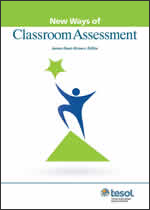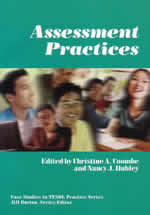Working the Weather: A Lesson Plan on Small Talk
by Martha Wilson
 Small talk is an essential part of our daily lives and some of the best relationships that I have began as small talk. It is important for students to understand the importance of this social networking skill in order to become good communicators. In the classroom, small talk can be used to teach students about various interaction strategies and speaking topics that are useful and authentic. By employing the same ritual in our classes, we can efficiently simulate the real-life situation while still maintaining a safe environment for students to make mistakes and to increase their willingness to communicate.
Small talk is an essential part of our daily lives and some of the best relationships that I have began as small talk. It is important for students to understand the importance of this social networking skill in order to become good communicators. In the classroom, small talk can be used to teach students about various interaction strategies and speaking topics that are useful and authentic. By employing the same ritual in our classes, we can efficiently simulate the real-life situation while still maintaining a safe environment for students to make mistakes and to increase their willingness to communicate.
| Materials: Whiteboard, markers, laptop, projector, worksheets (.docx) |
| Audience: Adult English learners, Intermediate to advanced adult/secondary learners |
| Objective: Students will be able to practice making small talk with their classmates using the tools and topics learned in class. |
| Outcome: Students will initiate small talk with strangers and write a one-paragraph summary about their experience. |
| Duration: 60–75 minutes (times are approximate) |
Warm-Up (10–15 minutes)
Step 1: Free Write
Begin the class with a journal writing/ free-writing activity. Topics may vary and the following questions can be adapted to your individual classroom:
- What did you do last weekend? Rate your weekend on a scale of 1 to 5.
- Have you seen/read/watched anything interesting lately? Please describe.
- What do you do for fun? What are your hobbies?
Step 2: Sharing Time
Instruct students to find a partner and to tell their partners about what they did over the weekend.
Step 3: Class Discussion
Call on a few students to share their stories or ask for volunteers.
Presentation (30 minutes)
Step 1: Tools for Small Talk
Before the Video
Distribute the worksheets (.docx) provided (can be printed one-sided or double-sided) before playing the video and go over the questions to make sure that the students understand each question.
During the Video
Play the video: “The Art of Small Talk,” by Jeffrey Benjamin (4:30).
- Students will answer “The Art of Small Talk Video Worksheet.”
- Repeat the video again if necessary.
After the Video
Instruct the students to find a partner to compare their answers and discuss their personal experiences with small talk and the effectiveness of the tools mentioned in the video.
Step 2: Topics for Small Talk
Worksheet: Making Predictions
Turn over to the next page of the worksheet and have students predict whether the topics listed on the page are appropriate or inappropriate. Model the task, and give examples if necessary.
Lesson
Discuss these topics with your class. Regardless of your instruction site, teachers are encouraged to have a good understanding of the target culture where instruction is taking place prior to introducing this lesson and be able to provide insight into these topics for the students. If you are not native to the target culture, some familiarization with these topics may be required before teaching this lesson.
Share your own experiences dealing with these topics. For example, instances when inappropriate topics made you feel uncomfortable or when appropriate topics became the starting point of a good friendship or relationship.
Sharing Time & Class Discussion
Instruct students to answer the discussion questions with a partner and call on a few volunteers to share their answers or their experiences with these topics.
Practice (20–25 minutes)
Step 1: Role-Play
Students will practice making small talk with at least three different partners for 5 minutes each.
- Taking the possible scenario from the discussion questions, write one scenario on the board and pretend that the whole class is waiting at a bus stop. Model the task and give examples. Have students role-play and initiate small talk with one other person for about 5 minutes.
- While the students are role-playing, write another scenario on the board for the next scene (in an elevator). Have the students recreate an elevator scene and initiate small talk with a different person.
- Repeat this step one more time with another scenario.
Step 2: Student Demonstration
Ask for volunteers or call on a few pairs to demonstrate their small talk scene. Rewards may be provided as incentive (extra credit points, candies, cookies, etc.).
Production
Homework/Project
For homework, instruct the students to initiate small talk with at least three strangers outside of class and write a one-paragraph summary of their experiences.
- This may be done over the weekend or due at a later date to give time for students to collect their data.
- Ask students to share their experiences with a partner next time in class.
References
Benjamin, J. (2008, December 12). The art of small talk [Video file]. Available from http://www.youtube.com/watch?v=jYeX5oEw0h8
____________________
Martha Wilson works as an ESL Instructor at Newton International College in Garden Grove, California and is currently a graduate student in the TESOL program at California State University, Fullerton. She is planning to complete her Master’s degree in May and is serving as the Vice President of the TESOL Club for the 2012–2013 school year.
TESOL Blogs
Interested in writing a blog for TESOL?
Contact
Tomiko Breland with your idea or for details.
Check out the latest TESOL Blogs:
|
Unearthing the Secrets of Successful Adult ELLs, by Alexandra Lowe
 Years ago, a social worker friend taught me that the best way to help people tackle difficult challenges was to focus on past instances of success rather than on failure. Success, he told me, was worthy of detailed investigation: What factors contributed to successful outcomes? And how can we encourage more of what has worked well in the past for others who are similarly situated? Years ago, a social worker friend taught me that the best way to help people tackle difficult challenges was to focus on past instances of success rather than on failure. Success, he told me, was worthy of detailed investigation: What factors contributed to successful outcomes? And how can we encourage more of what has worked well in the past for others who are similarly situated?
When I began teaching English as a second language, this advice came to mind. As I watched my adult immigrant students struggle to master our verb tenses or wrap their tongues around our sound system, I decided that it might be useful to investigate how successful adult ELLs went about achieving fluency in English. What were the secrets of their success? What strategies had worked well for them? Read More. |
|
Online Education: Ready, Set, Learn!, by Tara Arntsen
 Perhaps as a teacher you’ve found yourself thinking about how great it would be to go back to school and learn more about different aspects of the field of education, brush up on some of your skills, or even learn something entirely new. Or not. Either way, it’s not a bad idea. Let me introduce Coursera and edX, which are both websites that offer free courses from top-notch universities around the world. Read More. Perhaps as a teacher you’ve found yourself thinking about how great it would be to go back to school and learn more about different aspects of the field of education, brush up on some of your skills, or even learn something entirely new. Or not. Either way, it’s not a bad idea. Let me introduce Coursera and edX, which are both websites that offer free courses from top-notch universities around the world. Read More.
|
|
Global Resources in ESP: Two books on Professional Communication, by Kevin Knight
 Hello, ESPers worldwide! Hello, ESPers worldwide!
I am more excited than ever about the future of ESP because there is a growing need worldwide for communication skills in professional and academic settings. At TESOL 2013, I came across a wonderful book at the Routledge booth:
S. Schnurr (2012). Exploring Professional Communication: Language in Action. Abingdon, England: Routledge.
If you are new to the field of professional communication, I highly recommend it.
At TESOL, I find that many members have acquired expertise in training and in obtaining stakeholder agreement, which is necessary for creating and implementing training programs for many different types of organizations. Read More. |
TESOL Bookstore

Now It’s Easy to Assess Your English Language Learners
TESOL Press Books on Assessment Can Help
 New Ways of Classroom Assessment, revised
New Ways of Classroom Assessment, revised
James Dean Brown, Editor
In this revised edition in the popular New Ways Series, teachers have once again been given an opportunity to show how they do assessment in their classrooms on an everyday basis. This collection of ideas was contributed by teachers whose aim was clearly to help their students. Consequently, the activities are thoroughly integrated into the language teaching and learning processes. More than 100 activities enlighten both students and teachers about the effectiveness of their language learning and teaching but do not stand out as different, formal, threatening, or interruptive in the classroom.
 Assessment Practices
Assessment Practices
Christine Coombe and Nancy Hubley, Editors
For language educators, teachers, and testers, these studies analyze assessment design, implementation, and review for classrooms, formal tests, programs, curricula, and self-assessment in global scenarios.
Toll Free: 888-981-0041
E-mail: tesol@brightkey.net